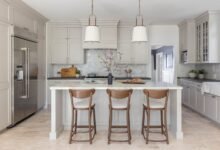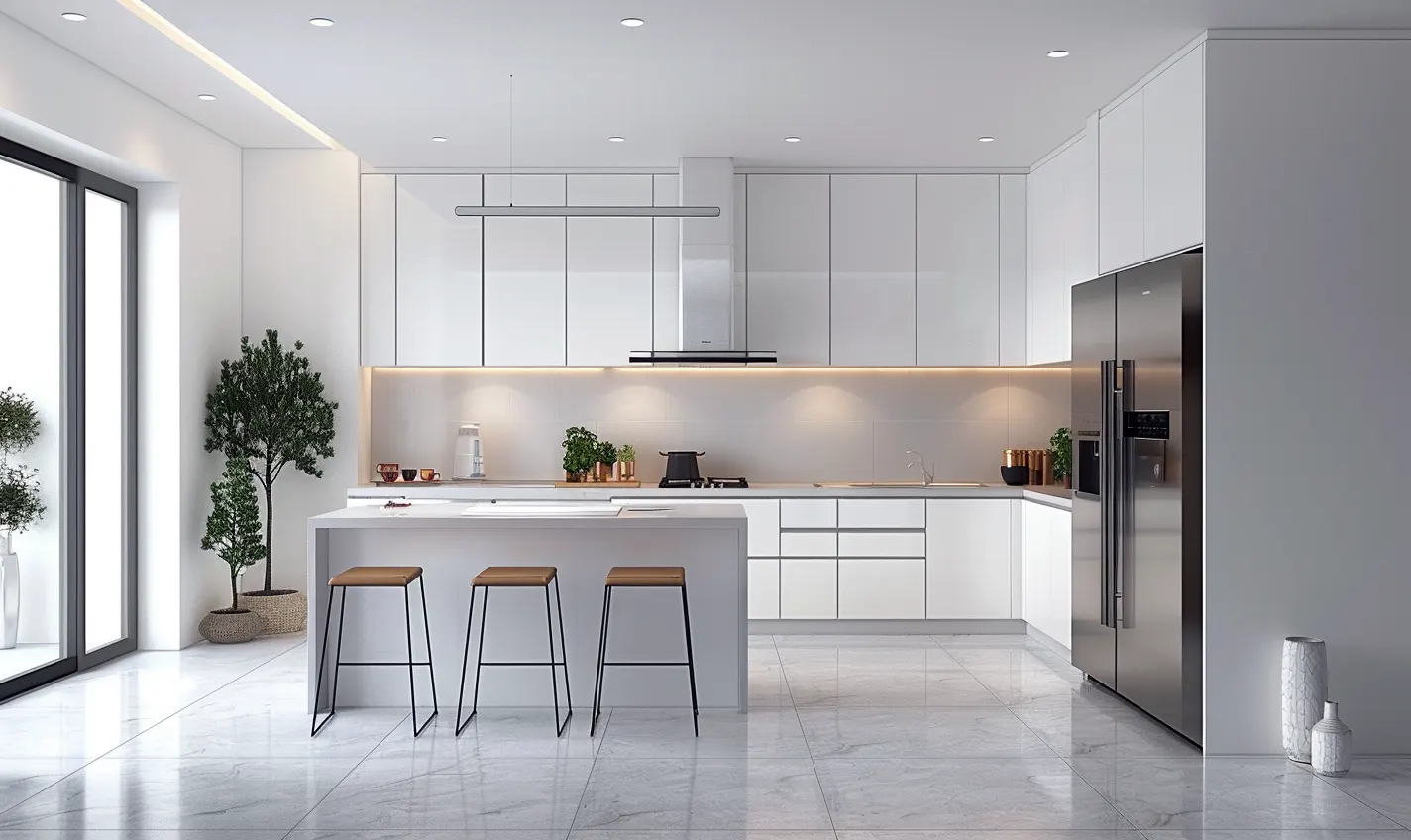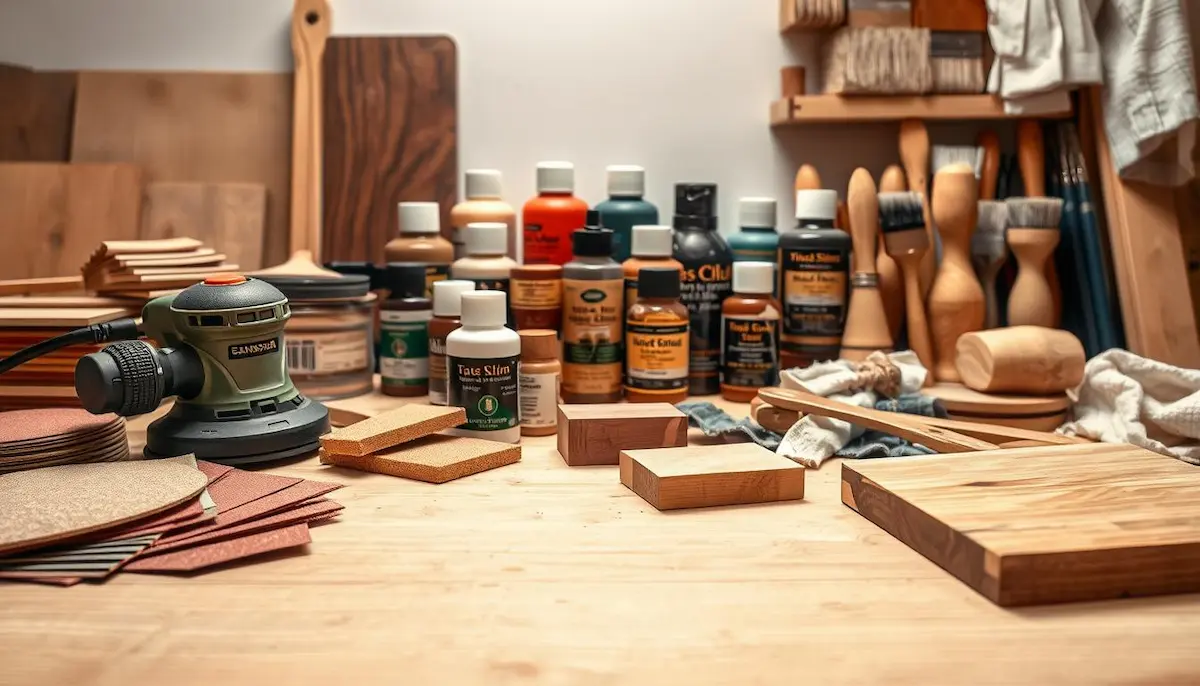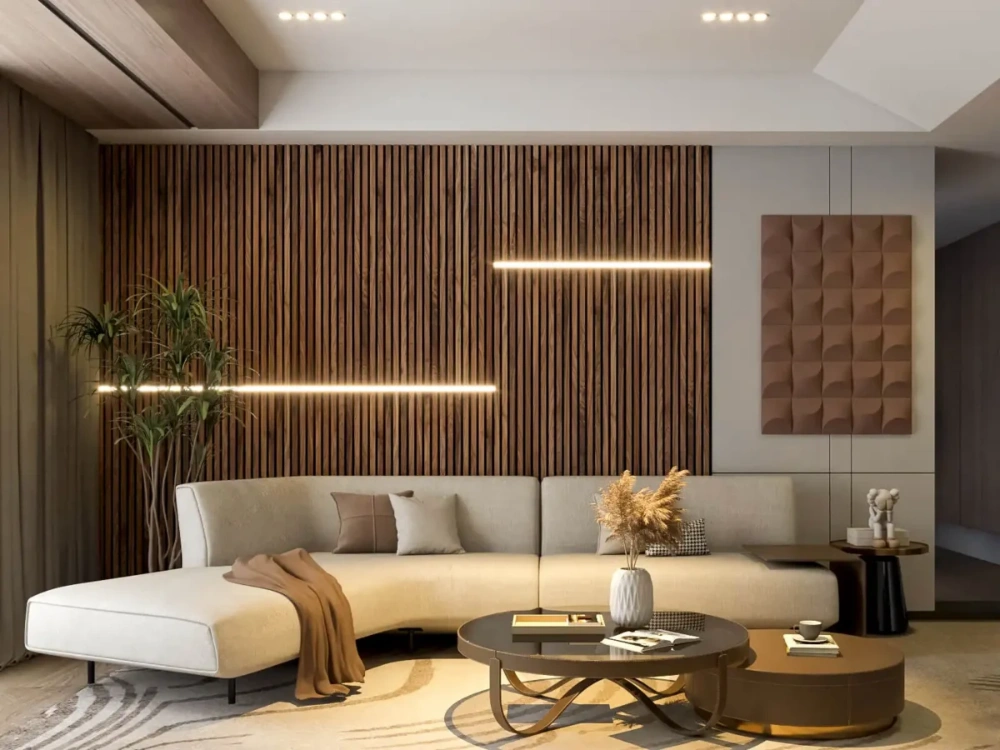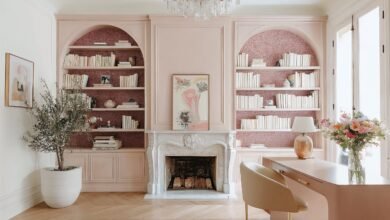Elevate Your Home with This Furniture Design Guide
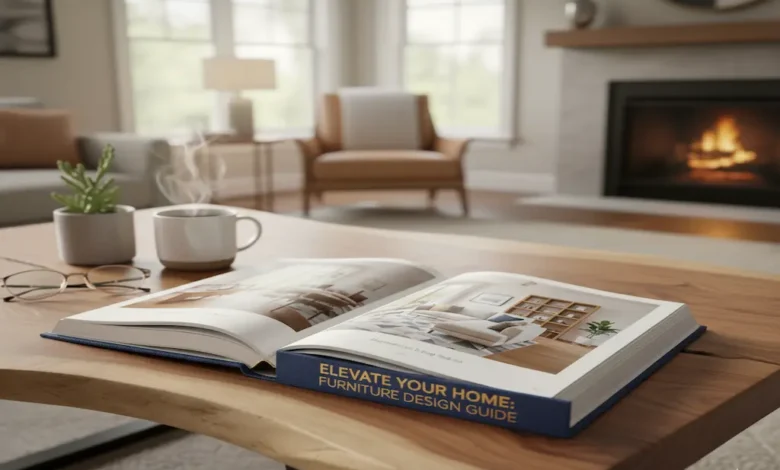
Transforming your living space into a haven of comfort and style begins with the right furniture choices. The way you furnish your home not only reflects your personal taste but also significantly impacts the ambiance and functionality of your living areas.
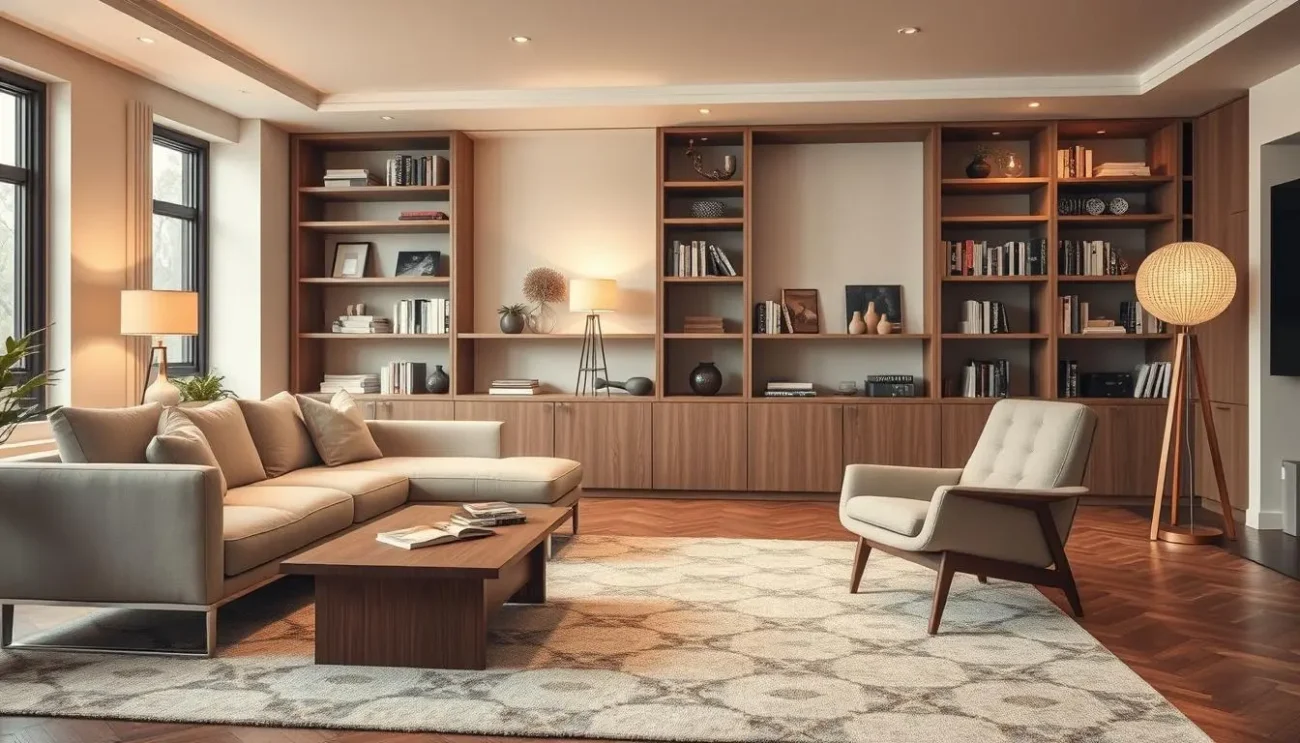
A well-planned furniture layout can make even the smallest rooms feel spacious and inviting. This comprehensive guide will walk you through the principles of effective Furniture Design Guide, helping you create a home that is both beautiful and functional.
By understanding the basics of furniture arrangement and staying abreast of the latest trends, you’ll be empowered to make informed decisions that elevate your home’s aesthetic and livability.
Key Takeaways
- Understand the principles of effective furniture design
- Learn how to create a functional and beautiful home
- Discover the latest trends in furniture arrangement
- Make informed decisions to elevate your home’s aesthetic
- Maximize the livability of your living spaces
Understanding Your Space Before Selecting Furniture
Before choosing the perfect furniture, it’s essential to understand the layout and dimensions of your space. This foundational step ensures that your furniture fits comfortably and enhances the room’s functionality.
Measuring Room Dimensions and Mapping Layout
Accurate measurements are crucial for a successful furniture layout. To achieve this, you’ll need the right tools and a clear understanding of your room’s layout.
Essential Tools for Accurate Measurements
To measure your room effectively, you’ll need a few essential tools:
- Tape measure
- Graph paper
- Laser measure (optional)
Creating a Floor Plan Sketch
With your measurements in hand, create a detailed floor plan sketch. This visual representation will help you identify potential furniture placement and traffic flow patterns.
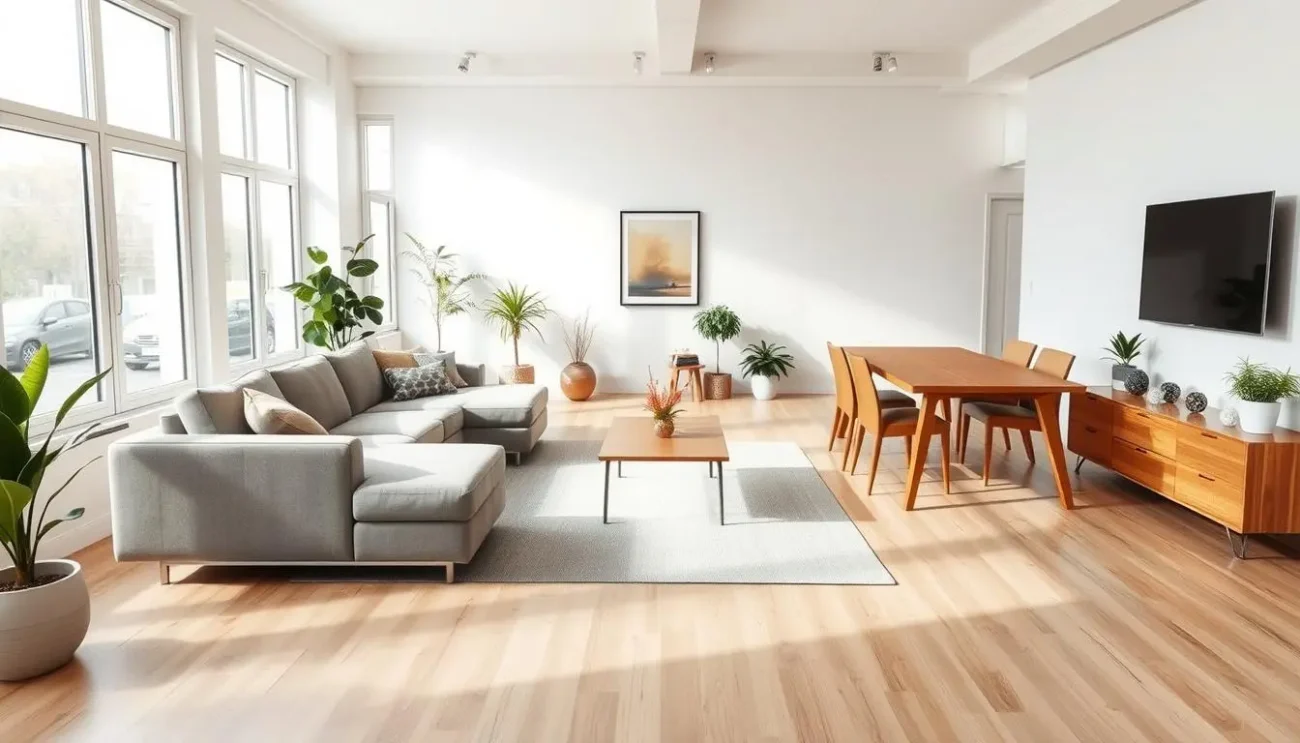
Analyzing Traffic Flow Patterns
Understanding how people move through your space is vital for creating a functional furniture layout. Consider the paths people take and how they interact with the room’s different areas.
Identifying Natural Light Sources and Focal Points
Natural light and focal points can significantly impact your furniture arrangement. Identify the sources of natural light and any focal points, such as fireplaces or stunning views, to create a harmonious and inviting space.
| Room Feature | Consideration | Design Tip |
|---|---|---|
| Natural Light | Placement of windows and doors | Position furniture to maximize natural light |
| Focal Points | Fireplaces, views, or architectural features | Arrange furniture to draw attention to these features |
| Traffic Flow | Paths and circulation | Create a clear path through the room |
By understanding your space and considering these factors, you can create a furniture layout that is both functional and aesthetically pleasing, incorporating valuable interior design tips and furniture layout ideas.
The Complete Furniture Design Guide for Modern Homes
Creating a modern home requires a deep understanding of current furniture trends and design principles. As highlighted by The New York Post, staying updated with the latest furniture trends is crucial for a stylish and functional living space.
Defining Your Personal Interior Design Style
Your interior design style is a reflection of your personality and preferences. To define your style, consider the following popular design styles:
- Modern Minimalism: Characterized by clean lines, minimal ornamentation, and an emphasis on function over form.
- Industrial Chic: Incorporates elements of old factories and industrial spaces, such as exposed brick and metal accents.
- Scandinavian Simplicity: Focuses on functionality, simplicity, and a connection to nature.
Popular Design Styles and Their Characteristics
Understanding the characteristics of different design styles can help you make informed decisions when selecting furniture and decor.
- Mid-Century Modern: Known for its organic shapes, simple lines, and integration with nature.
- Bohemian Eclectic: A mix of vintage and global elements, often featuring bold colors and patterns.
Mixing Styles Successfully
Mixing different styles can add depth and visual interest to your space. To do this successfully, focus on common elements such as:
- Color palette
- Texture
- Scale
Creating a Cohesive Design Plan
A cohesive design plan ties together your furniture, decor, and overall aesthetic. To achieve this, consider creating a mood board or visual inspiration board to guide your design decisions.
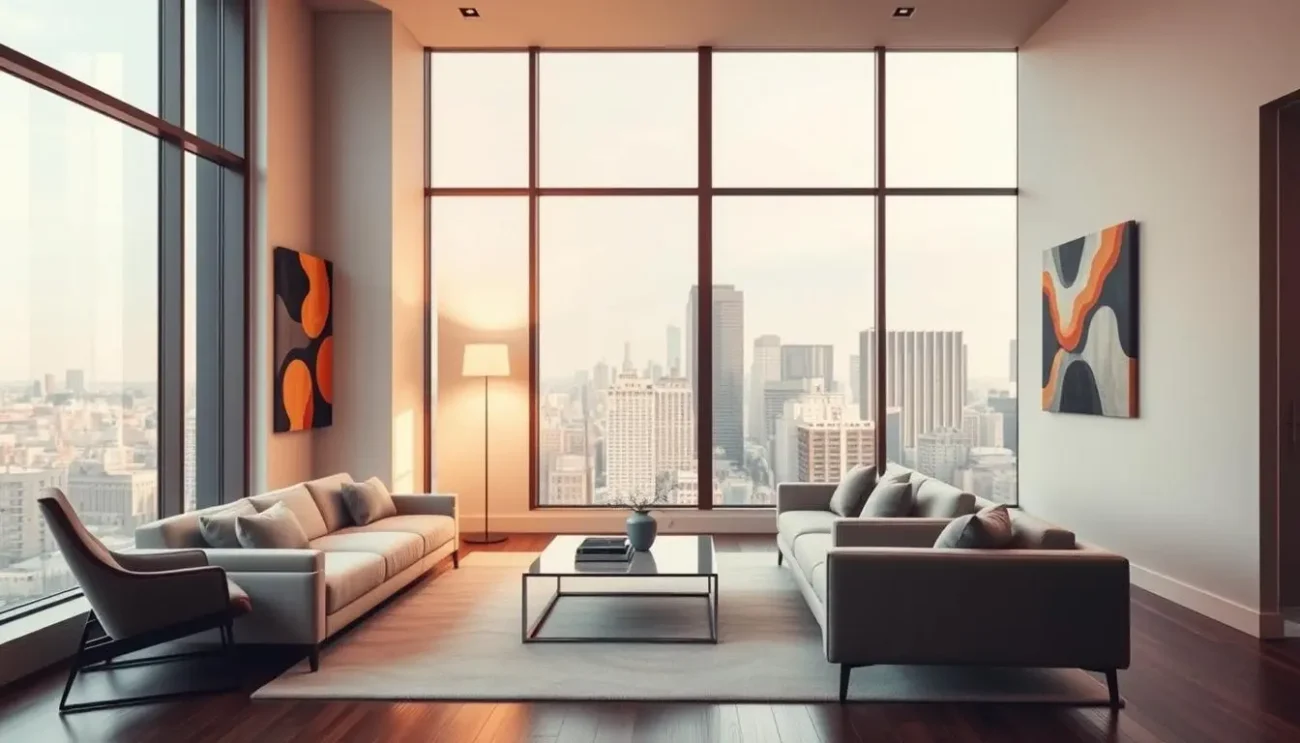
Balancing Functionality with Aesthetic Appeal
The key to a successful furniture design is balancing functionality with aesthetic appeal. This means selecting pieces that are not only beautiful but also serve a purpose.
By considering factors such as comfort, durability, and versatility, you can create a space that is both stylish and functional.
Selecting the Perfect Furniture Pieces for Each Room
To create a cohesive and inviting home, it’s essential to choose furniture that complements the purpose and layout of each room. The right furniture can enhance the functionality and aesthetic appeal of your living space.
Living Room Furniture Essentials
The living room is often the heart of the home, where family and friends gather to relax and socialize. Selecting the right furniture is crucial for creating a welcoming atmosphere.
Sofa and Seating Selection Guide
When choosing a sofa, consider the size of your room, the number of people it will seat, and the style that fits your decor. A comfortable and stylish sofa is the centerpiece of any living room.
- Measure your room to determine the ideal sofa size.
- Consider the color and fabric that will complement your existing decor.
- Think about additional seating options, such as armchairs or ottomans.
Coffee Tables, Entertainment Centers, and Accent Pieces
Coffee tables and entertainment centers are not just functional; they can also be stylish additions to your living room. Accent pieces like vases, lamps, or artwork can add personality to your space.
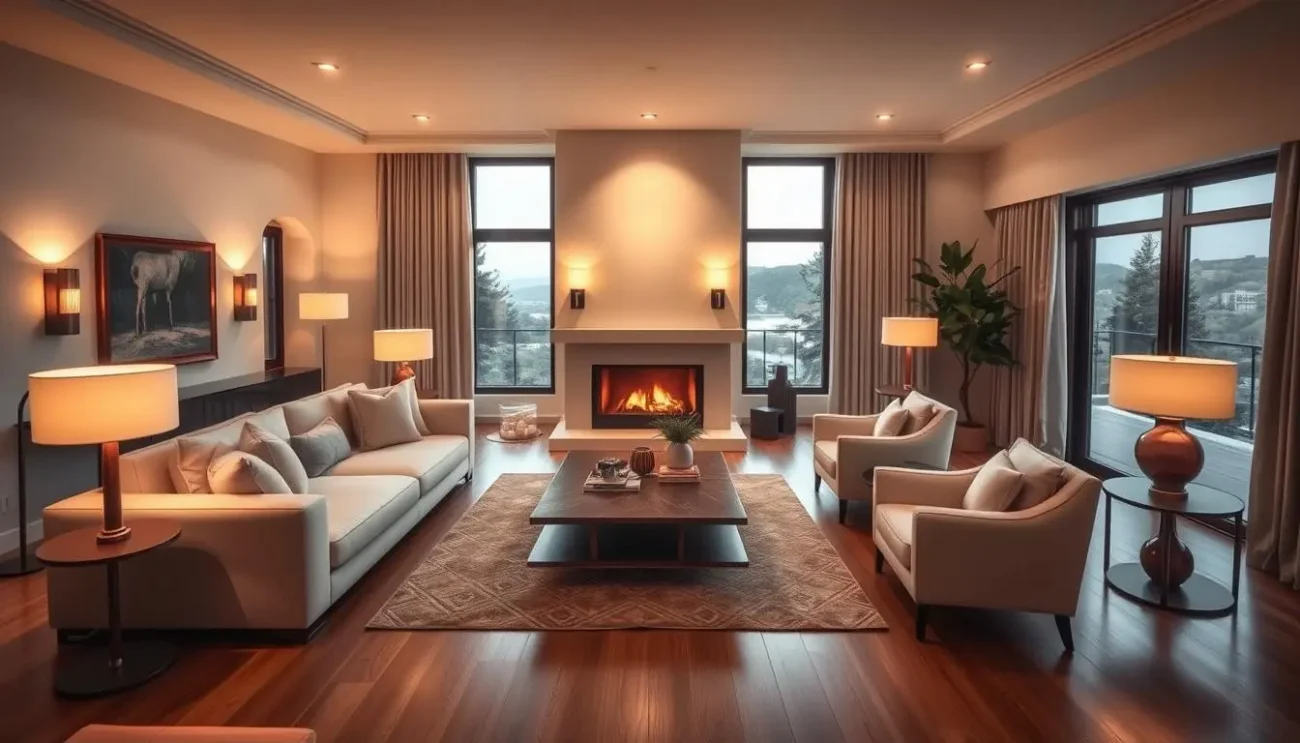
Bedroom Furniture Selection
The bedroom should be a sanctuary, a place to relax and unwind. Choosing the right bed and storage furniture is essential for creating a peaceful retreat.
- Select a bed that is comfortable and suits the size of your bedroom.
- Consider dressers, nightstands, and other storage pieces that fit your needs.
Dining Area and Kitchen Considerations
In the dining area and kitchen, functionality is key. Choose furniture that is both practical and stylish, such as a dining table that can accommodate your family and guests.
Home Office and Specialty Spaces
For home offices and specialty spaces, consider furniture that promotes productivity and comfort. A well-designed workspace can make a significant difference in your work-from-home experience.
Mastering Furniture Layout Ideas for Maximum Impact
Mastering furniture layout ideas is essential for maximizing the potential of your living space. A well-designed furniture arrangement can enhance the aesthetic appeal of your home while improving its functionality.
Fundamental Principles of Furniture Arrangement
The key to a successful furniture layout lies in understanding the fundamental principles of arrangement. This includes considering the room’s purpose, the flow of traffic, and the placement of furniture in relation to doorways and windows.
- Identify the room’s focal point and arrange furniture around it.
- Consider the traffic flow and leave enough space for easy movement.
- Balance the room with a mix of furniture sizes and shapes.
Creating Inviting Conversation Areas
Creating inviting conversation areas is crucial for making your living space comfortable and engaging. To achieve this, consider the following:
- Place seating furniture in a circular or U-shaped configuration to facilitate conversation.
- Use a coffee table or ottoman as a central gathering point.
- Add decorative elements such as rugs and lighting to create a cozy atmosphere.
Balancing Proportions and Scale in Your Space
Balancing proportions and scale is vital for creating a harmonious furniture layout. This involves considering the size of furniture in relation to the room and other pieces.
Working with Ceiling Heights
Ceiling height can significantly impact the perceived size of a room. To maximize the effect, use furniture with clean lines and minimal vertical elements in low-ceilinged rooms.
Managing Visual Weight
Managing visual weight involves balancing the distribution of heavy and light elements in a room. This can be achieved by:
- Distributing heavy furniture pieces throughout the room.
- Using lighter colors and materials to create a sense of openness.
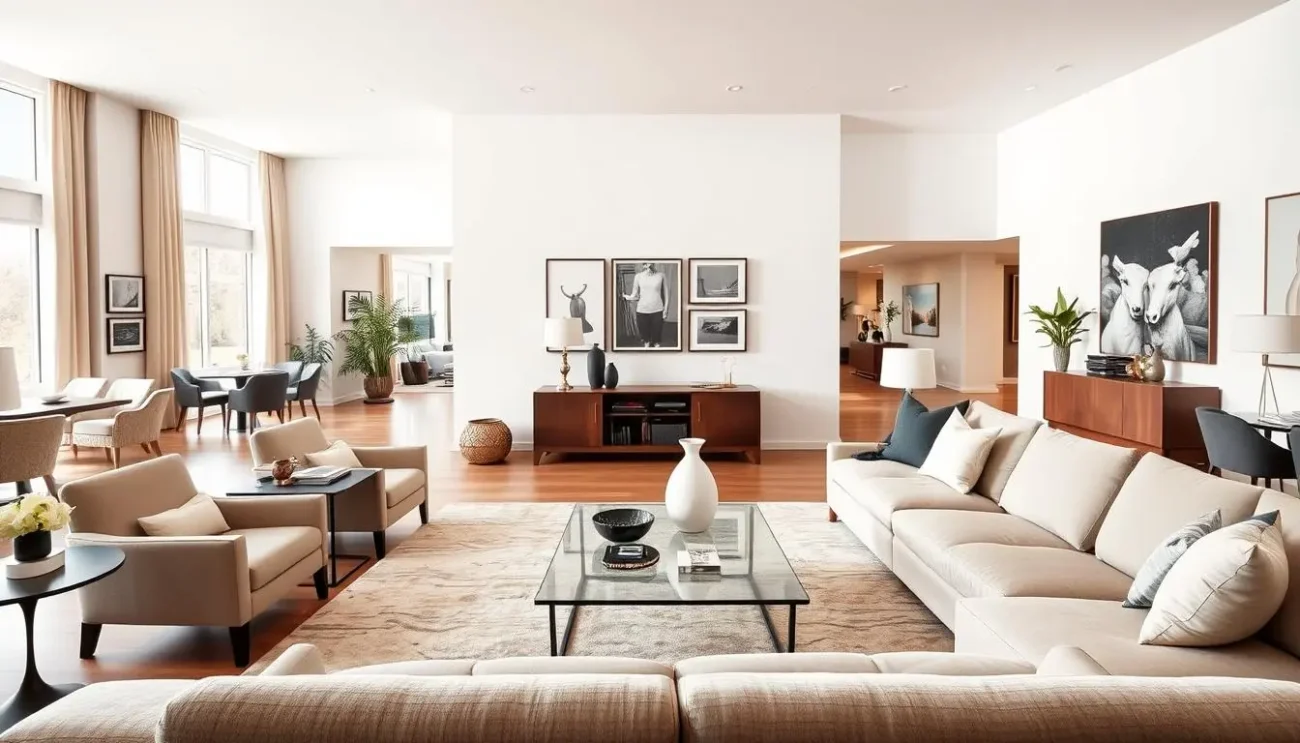
By applying these principles, you can create a furniture layout that not only looks great but also enhances the functionality of your living space. For custom furniture designs, consider consulting with a professional to ensure your furniture meets your specific needs and preferences.
Exploring Popular Furniture Materials and Their Benefits
The selection of furniture materials plays a crucial role in defining the character and durability of your living spaces. With a wide array of options available, understanding the unique characteristics of each material is essential for making informed decisions.
Wood Types and Their Unique Characteristics
Wood remains a popular choice for furniture due to its natural beauty and durability. Different types of wood, such as oak, maple, and cherry, offer distinct grain patterns and colors that can add warmth and character to a room. Hardwoods like oak are particularly prized for their strength and resistance to wear.
Metal, Glass, and Stone Applications in Modern Design
Metal, glass, and stone are frequently used in modern furniture design to create sleek, sophisticated pieces. Metal offers strength and versatility, while glass can add a touch of elegance and openness. Stone, such as marble or granite, can bring a sense of luxury and durability to furniture designs.
Choosing Upholstery Fabrics and Leathers
When it comes to upholstery, the choice between fabrics and leathers depends on personal preference, lifestyle, and the intended use of the furniture. Leather is durable and easy to clean, while fabric offers a wider range of colors and patterns.
Sustainable and Eco-Friendly Material Options
With growing environmental concerns, sustainable and eco-friendly materials are becoming increasingly popular. Options include reclaimed wood, bamboo, and eco-friendly fabrics made from recycled materials. Choosing these materials can help reduce your environmental footprint.
Incorporating Modern Furniture Trends in Your Home
Incorporating modern furniture trends can elevate your living space, making it more functional and aesthetically pleasing. The latest trends focus on combining style with practicality, ensuring that your home is both beautiful and livable.
Multifunctional and Transformable Furniture Pieces
Modern homes are embracing multifunctional furniture that serves more than one purpose. Examples include sofa beds, storage ottomans, and extendable dining tables. These pieces are perfect for small spaces or for maximizing functionality in larger homes.
Biophilic Design Elements and Natural Materials
Biophilic design, which incorporates elements of nature into the home, is gaining popularity. This includes using natural materials like wood, stone, and plants to create a more organic and welcoming environment.
Vintage Revival and Creative Upcycling Approaches
Vintage revival and upcycling are also trending, as homeowners look to give old furniture a new life. This not only reduces waste but also adds unique character to a room.
Mid-Century Modern Resurgence
The mid-century modern style is experiencing a resurgence, characterized by clean lines, organic shapes, and a focus on functionality.
Artisanal and Handcrafted Furniture
There’s also a growing appreciation for artisanal and handcrafted furniture, which offers a personal touch and supports local craftsmanship.
| Trend | Description | Benefits |
|---|---|---|
| Multifunctional Furniture | Sofa beds, storage ottomans | Space-saving, versatile |
| Biophilic Design | Natural materials, plants | Organic feel, welcoming |
| Vintage Revival | Upcycled, repurposed furniture | Unique, eco-friendly |
Implementing Space-Saving Furniture Solutions
Maximizing living space is crucial in modern homes, and space-saving furniture solutions are key to achieving this goal. As homes become more compact, the need for efficient and multifunctional furniture grows.
Convertible and Expandable Furniture Options
Convertible furniture pieces, such as sofa beds and extendable dining tables, offer versatility and functionality. These items can adapt to different needs, making them ideal for small spaces.
Wall-Mounted and Floating Furniture Ideas
Wall-mounted shelves and floating desks are excellent for creating a sense of openness. They keep floors clear, improving traffic flow and making rooms appear larger.
Strategic Storage Solutions for Small Spaces
Effective storage is vital in compact homes. Strategic storage solutions include:
- Under-bed storage systems
- Vertical storage units
- Furniture with hidden compartments
Under-Bed and Vertical Storage Systems
Under-bed drawers and vertical storage units maximize often-wasted space, keeping belongings organized and out of sight.
Furniture with Hidden Compartments
Furniture pieces with hidden compartments, like ottomans with storage, provide additional space for storing items, maintaining a clutter-free environment.
By incorporating these space-saving furniture solutions, homeowners can create more functional and comfortable living spaces, even in the most compact environments.
Creating Custom Furniture with DIY Projects
Embarking on DIY furniture projects can be a rewarding way to personalize your living space. The MERGE research study highlights a growing interest in DIY projects and customization, showing that homeowners are eager to put their own stamp on their furniture.
Upcycling Existing Furniture Pieces
Upcycling old furniture not only reduces waste but also allows you to create unique pieces that reflect your personal style. Refinishing and painting are popular techniques used to breathe new life into outdated furniture.
Refinishing and Painting Techniques
Refinishing involves stripping the old finish and applying a new one, while painting can completely transform the look of a piece. Both methods require careful preparation and execution.
Hardware Updates and Modifications
Updating hardware can be a simple yet effective way to modernize your furniture. Replacing old knobs or handles with new ones can make a significant difference.
Simple Building Projects for Beginners
For those new to DIY, starting with simple projects is key. Building a basic shelf or a small table can be a great introduction to working with tools and materials.
| Project | Skill Level | Materials Needed |
|---|---|---|
| Simple Shelf | Beginner | Wood, screws, drill |
| Small Table | Beginner | Wood, legs, screws |
Customizing Store-Bought Furniture
Even store-bought furniture can be personalized. Adding unique hardware or applying a fresh coat of paint can make a mass-produced piece stand out.
By embracing DIY furniture projects, you can create a home that truly reflects your personality and style. Whether you’re upcycling old pieces or building new ones from scratch, the possibilities are endless.
Mastering Furniture Decoration and Styling Techniques
Effective furniture decoration is not just about choosing the right pieces, but also how you style them. To create a harmonious and inviting space, it’s essential to understand the principles of furniture styling.
Accessorizing with Textiles, Pillows, and Throws
Textiles, pillows, and throws are versatile elements that can add color, texture, and warmth to your furniture. Mixing patterns and textures can create a visually appealing arrangement. For instance, combining a velvet sofa with linen pillows and a chunky throw blanket can add depth to your living room.
Incorporating Plants and Natural Elements
Incorporating plants and natural elements into your furniture decoration can bring a sense of calm and serenity to your space. Choose low-maintenance plants like succulents or air plants that fit your lifestyle.
Creating Visual Interest with Art and Decorative Objects
Art and decorative objects can add personality to your space. Consider creating a gallery wall or displaying a statement piece, like a sculpture or vase.
Styling Bookshelves and Display Areas
Bookshelves and display areas offer opportunities to showcase your personal style. Balance decorative objects with books and vary the heights and textures of the items displayed.
Seasonal Décor Rotation Strategies
Rotating your decor seasonally can keep your space feeling fresh. Store off-season items properly to maintain their condition.
| Decoration Element | Tips | Benefits |
|---|---|---|
| Textiles, Pillows, Throws | Mix patterns and textures | Adds color and warmth |
| Plants and Natural Elements | Choose low-maintenance plants | Brings calm and serenity |
| Art and Decorative Objects | Create a gallery wall or display statement pieces | Adds personality to the space |
By mastering these furniture decoration and styling techniques, you can create a beautiful and inviting home that reflects your personal style.
Utilizing Furniture Design Software and Tools
With the advent of advanced furniture design software, homeowners and professionals alike can now create custom furniture designs with unprecedented ease. The array of digital tools available today has revolutionized the furniture design process, making it more efficient, cost-effective, and highly personalized.
Free and Paid Design Applications for Home Use
Furniture design software comes in various forms, ranging from free applications to professional-grade paid versions. Some popular options include SketchUp and RoomSketcher, which offer user-friendly interfaces for creating detailed floor plans and 3D models.
Virtual Room Planners and 3D Visualization
Virtual room planners enable users to create accurate 3D visualizations of their spaces, allowing for better furniture arrangement and design planning. These tools help in experimenting with different layouts and configurations before making any physical changes.
Augmented Reality Furniture Placement Apps
Augmented reality (AR) technology has given rise to innovative furniture placement apps that enable users to see how furniture would look in their space before making a purchase. Apps like IKEA Place utilize AR to provide a realistic preview of furniture in a room.
Taking Accurate Measurements with Digital Tools
Digital tools can also assist in taking precise measurements, reducing the likelihood of errors. Laser measuring devices and smartphone apps can help ensure accuracy in measuring rooms and furniture.
Creating Design Boards and Mood Collages
Design boards and mood collages are essential for visualizing the overall aesthetic of a space. Digital tools like Canva and Pinterest allow users to create these visual representations, making it easier to communicate design ideas and preferences.
Conclusion: Creating Your Personalized Furniture Design Plan
By following this comprehensive furniture design guide, you are now equipped with the knowledge to create a space that reflects your personal style and meets your functional needs. The key to a successful interior design is understanding your space, selecting the right furniture pieces, and balancing aesthetics with functionality.
As highlighted in the MERGE research study, creating personalized and engaging spaces is crucial for a home’s ambiance and functionality. By incorporating interior design tips, such as analyzing traffic flow patterns and identifying natural light sources, you can create a space that is both beautiful and functional.
To finalize your furniture design plan, consider your personal preferences, lifestyle, and the unique characteristics of your space. With these factors in mind, you can create a cohesive design plan that incorporates your favorite furniture pieces and interior design elements, resulting in a space that is truly yours.
FAQ
What are the key factors to consider when measuring room dimensions for furniture selection?
When measuring room dimensions, consider the length, width, and any obstacles such as heating vents, doorways, or windows. It’s also essential to measure the space where the furniture will be placed, taking into account the traffic flow and the location of doors and windows.
How can I create a cohesive design plan that balances functionality with aesthetic appeal?
To create a cohesive design plan, start by defining your personal interior design style and identifying the key elements you want to feature in your space. Consider the functionality of each room and the furniture pieces needed to achieve that functionality while maintaining a visually appealing atmosphere.
What are some popular furniture materials and their benefits?
Popular furniture materials include wood, metal, glass, and stone, each with its unique characteristics and benefits. Wood is a versatile and warm material, while metal adds a touch of modernity. Glass and stone bring a sense of elegance and sophistication to a room.
How can I incorporate modern furniture trends into my home decor?
To incorporate modern furniture trends into your home decor, consider multifunctional and transformable furniture pieces, biophilic design elements, and vintage revival approaches. These trends can add a touch of sophistication and style to your space.
What are some effective space-saving furniture solutions for small spaces?
Effective space-saving furniture solutions include convertible and expandable furniture options, wall-mounted and floating furniture ideas, and strategic storage solutions. These solutions can help maximize the use of space in small rooms.
Can I create custom furniture with DIY projects?
Yes, you can create custom furniture with DIY projects, such as upcycling existing furniture pieces, simple building projects for beginners, and customizing store-bought furniture. These projects allow you to add a personal touch to your space.
What are some tips for mastering furniture decoration and styling techniques?
To master furniture decoration and styling techniques, consider accessorizing with textiles, pillows, and throws, incorporating plants and natural elements, and creating visual interest with art and decorative objects. These techniques can add depth and personality to your space.
What furniture design software and tools are available for home use?
Various furniture design software and tools are available, including free and paid design applications, virtual room planners, and augmented reality furniture placement apps. These tools can help you visualize and plan your space.
How can I choose the right upholstery fabrics and leathers for my furniture?
When choosing upholstery fabrics and leathers, consider factors such as durability, stain resistance, and style. Look for materials that are suitable for your lifestyle and complement your overall design plan.
What are some eco-friendly furniture options available?
Eco-friendly furniture options include sustainable materials, reclaimed wood, and recycled materials. These options can help reduce your environmental footprint while adding a unique touch to your space.

